Our new addition to Braille 200, Tânia Cardoso, recently started learning Braille and combines daily training with the joy of being out and about. Today, we accompany Tânia on her journey through Berlin and her search for Braille.
A big thank you for your detailed experience diary and an even warmer welcome to the team!
Berlin at My Fingertips: Learning Braille While Feeling the City
I just recently started learning Braille, and as a sighted person, I am trying to find fun ways to practice. Since I’m also interested in art and architecture—and love any excuse to be outside on a sunny day—I decided to combine those passions and experience the city I live in, Berlin, in a new way: through touch. After some research and tips from colleagues, I headed to Berlin-Mitte to visit the exhibition of the Berliner inner-city model.
Berliner Stadt-Modelle Exhibition – Tactile Model
My first stop required an appointment, which I made by telephone. After some confusion—taking turns trying to find the right door number because of construction work on the street (not announced on Google Maps)—I finally found myself inside the building of the Berlin Senate Department for Mobility, Transport, Climate Protection and the Environment, Am Köllnischen Park 3, 10179 Berlin.
I was the only visitor at the time, which gave me the chance to take photos and explore the streets, buildings, and trees on the tactile model with my fingers while practicing Braille without distractions. The tactile model is located on the left side of the exhibition, and the area that can be touched is marked by a tactile floor. The other large city models on display, unfortunately, are not meant to be touched.
Besides the tactile model at a 1:2000 scale, there are larger sculptures of Berlin landmarks—such as the TV Tower, Brandenburg Gate, and Victory Column—at a 1:300 scale. These can also be touched, which is a wonderful way to understand the details of monuments that attract visitors from all over the world.
On the left side of the tactile model, I found a vertical-standing map titled Berliner Gewässer und Grünflächen. As a nature enthusiast, I found it particularly interesting. Different textures indicated green areas and water, such as lakes and rivers within each district of Berlin. The map included Braille labels, and a legend with explanations followed on the right-hand side.
To the right of the legend, in both Braille and print, the plaque reads:
Auftraggeber: Senatsverwaltung für Stadtentwicklung und Umwelt
Beratung: Deutscher Blinden- und Sehbehindertenverband e.V.
Allgemeiner Blinden- und Sehbehindertenverein e.V.
Gestaltung: Technische Universität Berlin Fach Modell+Design
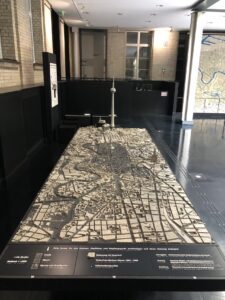
Photo description:
The photo shows a long table with the tactile model, in tones of black, grey and white, with some monuments elevated. Behind the model, the TV Tower is again displayed, but at a larger scale. On a black floor, a tactile floor marks the section of the exhibition where the models can be touched.
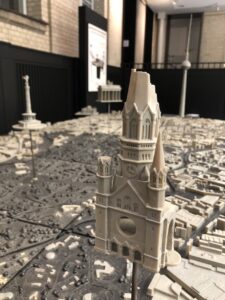
Photo description:
Detail of the city tactile model. The photo shows a close-up of the Gedächtniskirche, elevated above the map.
Visiting the Berliner Stadt-Modelle was great, but my curiosity wasn’t satisfied. I wanted to experience more detail and a livelier atmosphere, so I decided to take the train to the very touristic Museumsinsel.
Lustgarten on Museumsinsel – Tactile Model
At the Lustgarten, I discovered a tactile model of the Museumsinsel. On a sunny day, while tracing the shapes of the buildings and reading their names in Braille, I noticed the lively sounds around me: music played by street musicians from different corners simultaneously, people chatting in many languages, cars driving along Unter den Linden, and the bustle of an art flea market across the Spree River.
The bronze tactile model measures 150 × 70 cm, built at a 1:450 scale and mounted on a waist-high sandstone base With my fingertips, I could trace the Pergamon Museum, Bode-Museum, Alte and Neues Museum, Alte Nationalgalerie, the winding Spree River, and the impressive dome of the Berliner Dom.
On the plaque, written in Braille and in print, it says:
“Museumsinsel Berlin.
Den Staatlichen Museen zu Berlin gestiftet vom Rotary Club Berlin-Süd und dem Rotary Club Berlin-Nord zum gemeinsamen 50. Charterjubiläum am 30.9.2010.”
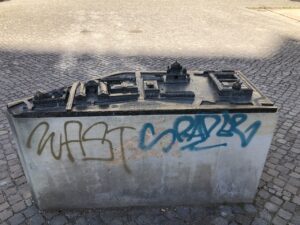
Photo description: The tactile model of the Museumsinsel, outdoors. The base of the model has some graffiti tags. Although it is part of the Lustgarten, it is located in an area without greenery, near the Spree.
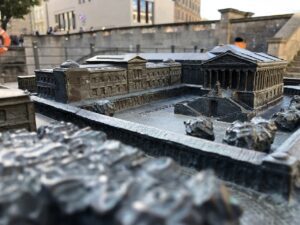
Photo description: Detail of the tactile model. The photo shows the Neues Museum with Braille inscription.
Unter den Linden – PalaisPopulaire Tactile Model
From the Lustgarten, I crossed the street toward the Humboldt Forum and, still close to the Museumsinsel, I unexpectedly—and happily—discovered another tactile sculpture. On the right side of the exhibition house PalaisPopulaire, a concrete base with a bronze model on top presents landmarks such as Bebelplatz, the Palais Populaire itself, the Staatsoper, and St. Hedwig’s Cathedral. The model was cast in gold bronze at a scale of 1:500. In both Braille and print, the inscription reads:
“Prinzessinnenpalais und Umgebung Unter den Linden, gestiftet vom PalaisPopulaire by Deutsche Bank, 2021.”
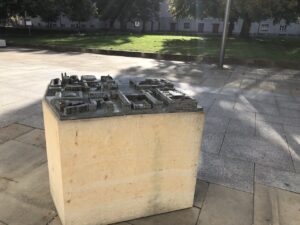
Photo description: The tactile model stands on a concrete base between the PalaisPopulaire and the Bebelplatz garden.
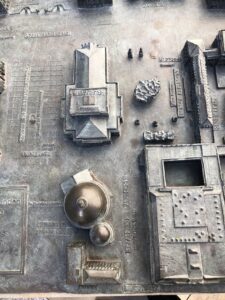
Photo description: Detail of the tactile model. The photo shows St. Hedwig’s dome, the Staatsoper, Bebelplatz, and part of the Palais Populaire, with Braille inscriptions next to each building or street.
This journey of discovering and feeling the shapes of Berlin with my fingertips has sparked my curiosity even more, and I will certainly continue searching for architectural tactile models and examples of Braille in the city that are free and accessible to everyone.
useful links:
Read all articles on: livingbraille.eu
Contact us with your contributions, ideas and questions by: braille200@livingbraille.eu
Social media: Braille 200 on Facebook